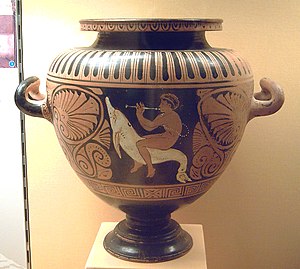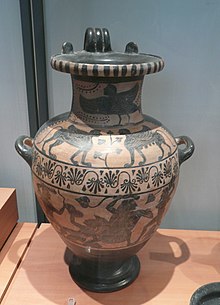Etruscan vase painting

Etruscan vase paintingwas produced from the 7th through the 4th centuries BC, and is a major element inEtruscan art.It was strongly influenced byGreek vase painting,and followed the main trends in style over the period. Besides being producers in their own right, theEtruscanswere the main export market for Greek pottery outside Greece, and some Greek painters probably moved toEtruria,where richly decorated vases were a standard element of grave inventories.
Black-figure vase painting[edit]

The local production of Etruscan vases probably began in the 7th century BC. Initially, the vases followed examples ofblack-figure vase paintingfromCorinthandEast Greece.It is assumed that in the earliest phase, vases were produced mainly by immigrants from Greece. The first major style was so-calledPontic vase painting.This was followed between 530 and 500 BC by theMicali Painterand his workshop. They mainly producedamphorae,hydriaiand jugs. Depictions includedkomasts,symposiaand animal friezes. Mythological motifs occur more rarely, but are already created with great care. By this time, Etruscan vase painting had begun to take its main influence fromAtticvase painting. The black-figure style ended about 480 BC. In its final phase, it had developed a tendency to mannerism and a sloppy silhouette style of drawing.
Red-figure vase painting[edit]
An imitative adoption of thered-figure techniqueonly developed in Etruria around 490 BC, nearly half a century after that style had been invented in Greece. Early produce is described as pseudo-red-figure Etruscan vase painting, due to its differing technique. Only by the end of the 5th century was the true red-figure technique introduced to Etruria. For both pseudo- and true red-figure, numerous painters, workshops and production centres have been recognised. Vases were not just produced for the local market, but also sold toMalta,Carthage,Romeand theLiguriancoast.
Pseudo-red-figure vase painting[edit]

Early vessels of this style merely imitated the red-figure technique. As on some early Attic vases, this was achieved by covering the whole vase body in black shinyslip,then adding figures on top, using paints that would oxidise into red or white during firing. In true red-figure, the red areas were left free of slip. In pseudo-red-figure, internal details were marked by incision, similar to the usual practice in black-figure vase painting, rather than painted on, as in true red-figure. Important representatives of this style were thePraxias Painterand other masters ofhis workshop,which was located atVulci.In spite of their extensive knowledge of Greekmythologyand iconography - not always executed perfectly - there is no evidence that these masters were Greek immigrants. An exception is the Praxias Painter himself: since four of his vases bear painted inscriptions in Greek, he may have been of Greek origin.[1]
In Etruria, the pseudo-red-figure style was not just an early phenomenon, as it had been in Athens. Especially in the 4th century BC, some workshops specialised in this technique, although true red-figure was widespread in Etruscan workshops at the same time. Examples include the workshops of theSokra Groupand thePhantom Group.The somewhat older Sokra Group had a preference for cups with interior images from Greek mythology, sometimes also with Etruscan motifs. The Phantom Group mostly painted cloaked figures in combination with compositions of plant orpalmettepatterns. The workshops of both groups are supposed to have been located inCaere,FaleriiandTarquinia.The Phantom Group produced its wares until the early 3rd century BC. Changing tastes on the buyers' part spelled the end not just of true red-figure but also of this style.[2]
Red-figure vase painting[edit]
Only towards the end of the 5th century was the true red-figure technique, with the figures as reserved areas remaining in the actual clay colour, introduced to Etruria. The first such workshops developed inVulciandFalerii,but also produced for surrounding areas. The original workshops were probably founded by Attic masters, but the early vessels also already display aSouth Italianinfluence. These workshops dominated the Etruscan market until the 4th century BC. Large and medium format vessels likekratersand jugs were mostly decorated with mythological scenes. During the course of the century, the production of Falerii began to outclass that of Vulci in terms of quantity. New centres of production developed inChiusiandOrvieto.Chiusi became especially important through theTondo Group,which produced drinking cups with mostlydionysiacmotifs on the inside. In the second half of the century, production moved toVolterra.Here, especially a certain type of craters, thekelebeswere produced and initially painted very elaborately.
In the second half of the 4th century BC, mythological themes disappeared from the repertoire of Etruscan vase painters. They were replaced with women's heads and figural depictions of not more than two persons. Instead, the vase bodies were now mostly covered with ornamental and floral motifs. Larger compositions now only occurred in exceptional cases, such as theamazonomachyon a krater by theHague Funnel Group Painter.The initially, still substantial, production of Falerii lost its dominant role to the newly founded production centre atCaere.The Caere workshops were probably founded by masters from Falerii; they lacked a separate tradition but became the main centre of red-figure vase production in Etruria. Its standard repertoire included simply paintedoinochoai,lekythoiand drinking cups (e.g. by theTorcop Group), and small plates (Genucuilia Group). By the end of the 4th century, a change in consumer tastes led to a shift towards the production ofblack-glazed ware,which marked the end of red-figure vase production in Etruria.[3]
Bibliography[edit]
- Matthias Steinhart:Schwarzfigurige Vasenmalerei II. Ausserattisch.In:Der Neue Pauly,vol. 11, cols. 276-281.
References[edit]
- ^Reinhard Lullies inAntike Kunstwerke aus der Sammlung Ludwig. Band 1. Frühe Tonsarkophage und Vasen,von Zabern, Mainz 1979, p. 178–181ISBN3-8053-0439-0.
- ^Huberta Heres – Max Kunze (Hrsg.):Die Welt der Etrusker, Archäologische Denkmäler aus Museen der sozialistischen Länder.Ausstellungskatalog Staatliche Museen zu Berlin, Hauptstadt der DDR – Altes Museum vom 04. Oktober bis 30. Dezember 1988. Berlin 1988, p. 245–249
- ^Huberta Heres – Max Kunze (Hrsg.):Die Welt der Etrusker, Archäologische Denkmäler aus Museen der sozialistischen Länder.Ausstellungskatalog Staatliche Museen zu Berlin, Hauptstadt der DDR – Altes Museum vom 04. Oktober bis 30. Dezember 1988. Berlin 1988, p. 249–263
